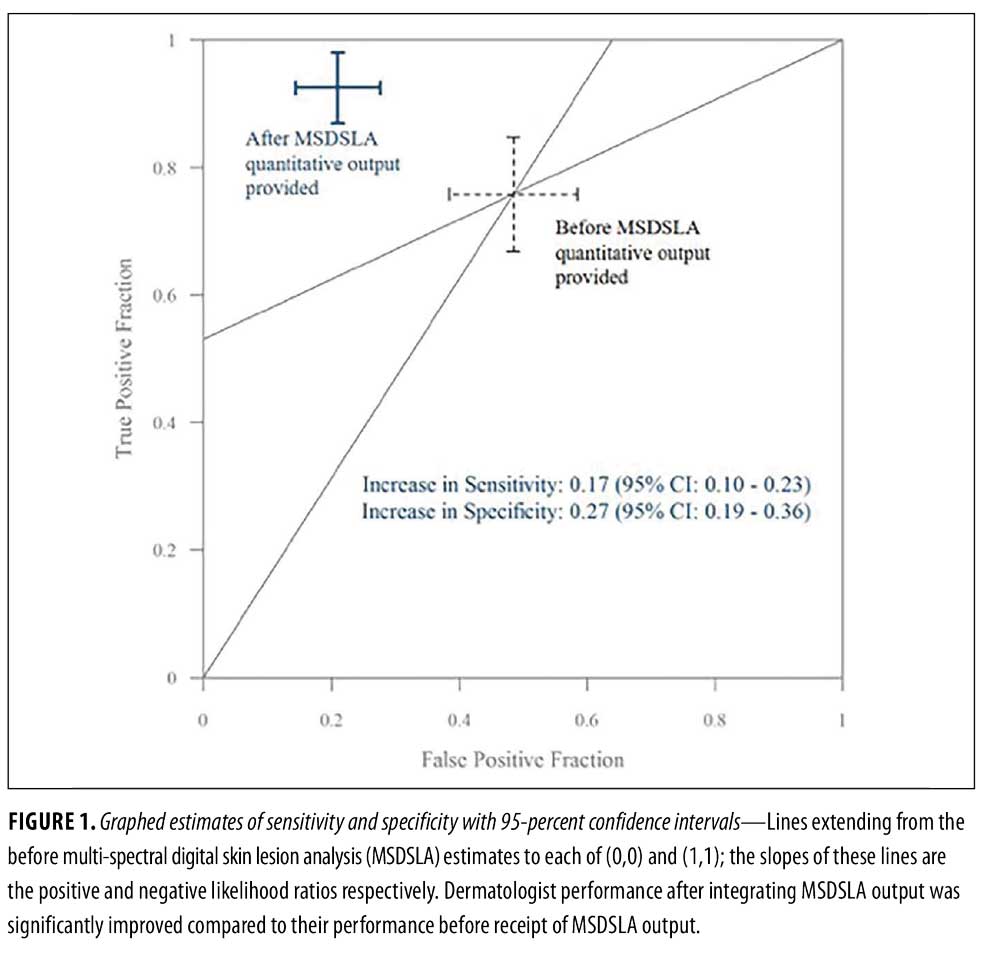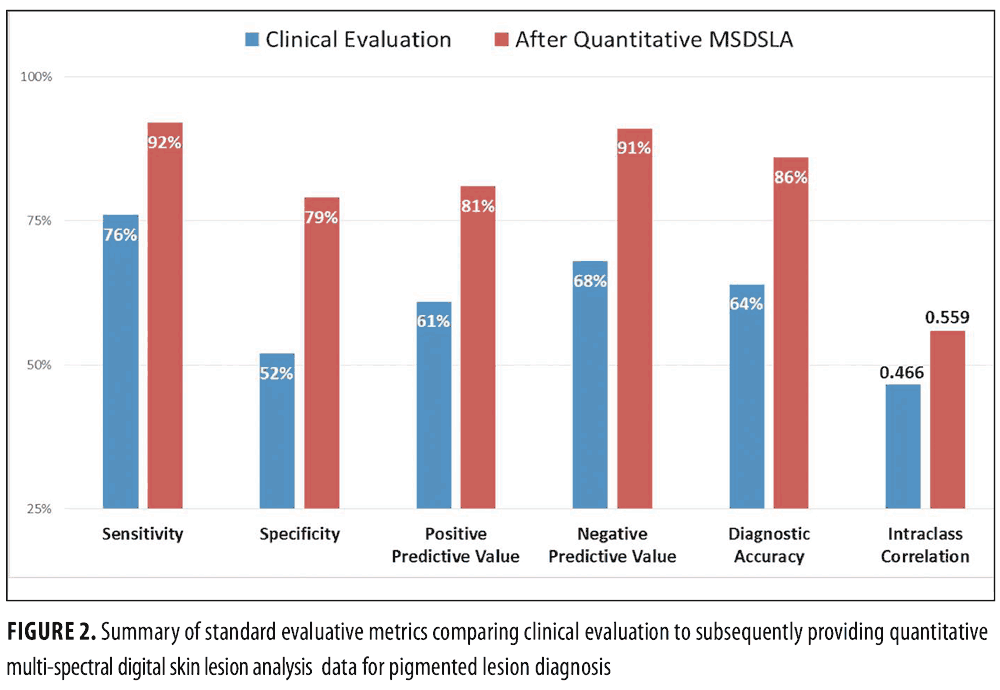 by Aaron S. Farberg, MD; Richard R. Winkelmann, DO; Natalie Tucker, BS; Richard White, MS; and Darrell S. Rigel, MD
by Aaron S. Farberg, MD; Richard R. Winkelmann, DO; Natalie Tucker, BS; Richard White, MS; and Darrell S. Rigel, MD
Dr. Farberg is with the Icahn School of Medicine, Dermatology, at Mount Sinai in New York, New York. Dr. Winkelmann is with Ohio Health, Dermatology, Columbus, Ohio. Ms. Tucker is with STRATA Skin Sciences Inc. in Horsham, Pennsylvania. Mr. White is with Iris Interactive System in Cody, Wyoming. Dr. Rigel is with the New York University School of Medicine, Dermatology, in New York, New York.
Funding: This study was funded in part by a grant from STRATA Skin Sciences Inc.
Disclosures: Drs. Farberg and Winkelmann’s clinical research fellowship was funded in part by STRATA Skin Sciences, Inc. Ms. Tucker is employed by STRATA Skin Sciences, Inc. Mr. White has no conflicts of interest to disclose. Dr. Rigel is a consultant to STRATA Skin Sciences, Inc.
Keywords: Melanoma, pigmented skin lesion, diagnostic technology, MelaFind, multi-spectral digital skin lesion analysis
Abstract: Background. Early diagnosis of melanoma is critical to survival. New technologies, such as a multi-spectral digital skin lesion analysis (MSDSLA) device [MelaFind, STRATA Skin Sciences, Horsham, Pennsylvania] may be useful to enhance clinician evaluation of concerning pigmented skin lesions. Previous studies evaluated the effect of only the binary output.
Objective. The objective of this study was to determine how decisions dermatologists make regarding pigmented lesion biopsies are impacted by providing both the underlying classifier score (CS) and associated probability risk provided by multi-spectral digital skin lesion analysis. This outcome was also compared against the improvement reported with the provision of only the binary output.
Methods. Dermatologists attending an educational conference evaluated 50 pigmented lesions (25 melanomas and 25 benign lesions). Participants were asked if they would biopsy the lesion based on clinical images, and were asked this question again after being shown multi-spectral digital skin lesion analysis data that included the probability graphs and classifier score.
Results. Data were analyzed from a total of 160 United States board-certified dermatologists. Biopsy sensitivity for melanoma improved from 76 percent following clinical evaluation to 92 percent after quantitative multi-spectral digital skin lesion analysis information was provided (p<0.0001). Specificity improved from 52 percent to 79 percent (p<0.0001). The positive predictive value increased from 61 percent to 81 percent (p<0.01) when the quantitative data were provided. Negative predictive value also increased (68% vs. 91%, p<0.01), and overall biopsy accuracy was greater with multi-spectral digital skin lesion analysis (64% vs. 86%, p<0.001). Interrater reliability improved (intraclass correlation 0.466 before, 0.559 after).
Conclusion. Incorporating the classifier score and probability data into physician evaluation of pigmented lesions led to both increased sensitivity and specificity, thereby resulting in more accurate biopsy decisions.
J Clin Aesthet Dermatol. 2017;10(9):24–26
Introduction
Early diagnosis of melanoma is critical to survival. In addition to traditional clinical assessment, newer technologies may be useful to enhance timely diagnosis and subsequent management of melanoma.[1] A multi-spectral digital skin lesion analysis (MSDSLA) device [MelaFind, STRATA Skin Sciences Inc., Horsham, Pennsylvania] has been shown to improve the decision to biopsy suspicious pigmented skin lesions (PSL) by dermatologists.[2–4] The technique employs 10 spectral bands of visible and near-infrared light (430–950nm) to image a lesion to 2.5mm below the skin surface. Using 75 unique computerized algorithms characterizing the PSL’s morphological structural disorder, MSDSLA provides an output of “high” or “low” disorganization based on a classifier score (CS). CS scores of zero or higher are considered “high” disorganization, which is associated with a 98.3-percent sensitivity to melanomas and high-grade lesions as demonstrated in the pivotal trial of MelaFind.[4]
The significant positive impact on melanoma diagnosis by providing only the binary “high/low” output has been reported.[5–7] However, additional objective information from the device might also be useful when integrated into a clinician’s biopsy decision. Using a logical regression model previously validated on a set of 1632 PSLs, the probability of melanoma or pigmented lesion of high-risk malignant potential can be calculated. The purpose of this study was to determine how decisions made by dermatologists regarding whether to biopsy pigmented lesions are impacted by providing both the underlying CS and associated probability that the lesion is melanoma or a high-grade dysplastic nevi (HGDN) beyond clinical inspection alone. This outcome was also compared against the improvement reported with the provision of only the binary output.
Methods
One hundred and sixty United States board-certified dermatologists (median duration of practice, 21–30 years) attending an educational conference were asked to evaluate 50 randomly ordered pigmented lesions (25 melanomas/ HGDN and 25 benign pigmented lesions including low-grade DNs). The lesions were randomly selected from a validated database of 1,632 pigmented lesions used for the MelaFind pivotal study. High resolution clinical (distant and close-up) and dermoscopic images of each lesion were displayed, after which participants were asked to decide if they would biopsy the lesions. MSDSLA information, including the probability graphs and CS, were then provided. Participants were asked again if they would biopsy the lesions. Individual responses before and after quantitative MSDSLA information were obtained to determine its effect on participant decision to biopsy. This study was approved by Western IRB (WIRB, Puyallup, Washington). Statistical analysis was performed using the analysis of variance (ANOVA) method, Chi Square, and intraclass correlation kappa statistic.
Results
The average biopsy sensitivity for melanoma/HGDN lesions improved from 76 percent following clinical evaluation to 92 percent after quantitative MSDSLA information was provided (p<0.0001), demonstrating superiority of sensitivity by dermatologists after seeing the MSDSLA output. In addition, specificity improved from 52 percent to 79 percent (p<0.0001). The overall improvement in both sensitivity and specificity is illustrated in Figure 1.

The positive predictive value of a decision to biopsy a lesion significantly increased from 61 percent to 81 percent (p<0.01) when the quantitative data were provided. Negative predictive value also increased (68% vs. 91%, p<0.01), and overall biopsy diagnostic accuracy was greater using MSDSLA than using clinical information alone (64% vs. 86%, p<0.001). Figure 2 summarizes the above listed standard evaluative metrics comparing clinical evaluation to evaluation using MSDSLA data for PSL diagnosis.

The addition of quantitative MSDSLA data into the decision process also led to a more consistent biopsy decision. The intraclass correlation as an estimate of interrater reliability improved from 0.466 before to 0.559 after integrating MSDSLA information.
Discussion
This study demonstrated that the decision by dermatologists to biopsy a pigmented lesion was significantly more sensitive, specific, and accurate after being provided quantitative MSDSLA data beyond clinical inspection alone. A prior study that provided only binary MSDSLA output revealed a similar increase in sensitivity, but concomitant decrease in specificity.[4] In contrast, incorporating the CS and probability data into the biopsy decision in the current study led to both increased sensitivity and specificity, thereby resulting in more accurate biopsy decisions. In addition, given that almost the same overall number of lesions were selected for biopsy before and after physicians were provided the quantitative MSDSLA data, the subsequent enhanced sensitivity and specificity led to an improved biopsy ratio (ratio of total biopsies to the number melanomas diagnosed), thereby reducing unnecessary biopsies.
Potential limitations of this study include the lack of opportunity for in-vivo lesion evaluation. Also, clinicians with a particular interest in skin cancer or technology may have self-selected to take part in the study. Therefore, the results of this study might not be generalized to the average level of expertise by practicing clinicians.
A number of emerging technologies are available to aid in the diagnosis and prognosis of melanoma, but a recent survey of United States dermatologists found that less than one percent currently regularly use these technologies in the routine evaluation of PSLs.[8] Due to the dynamic evolution of these technologies and absence of published recommendations, many dermatologists have yet to fully embrace these tools. Initial costs for the technologies may also be limiting. However, integration of objective clinical tools like MSDSLA to augment the clinician biopsy decision process have the potential to improve early melanoma detection while decreasing the healthcare costs associated with unnecessary biopsies or by decreasing overall disease burden.
The rising incidence of melanoma creates an imperative need for strategies that can improve early detection and subsequent patient outcomes. This study demonstrated that providing additional objective quantitative MSDSLA information improves the accuracy of decisions made by dermatologists to biopsy pigmented lesions. Of about 1.5 million skin biopsies performed in the United States each year to diagnose melanoma, only about seven percent are positive for melanoma and another 15 percent are equivocal.[9] Therefore, especially in this era of healthcare cost consciousness, the importance of being able to more accurately choose lesions to biopsy is becoming increasingly critical.
Acknowledgment
The authors thank Alicia Toledano for statistical analysis of the data.
References
- Rigel DS, Russak J, Friedman R. The evolution of melanoma diagnosis: 25 years beyond the ABCDs. CA Cancer J Clin. 2010;60(5):301–316.
- Elbaum M, Kopf AW, Rabinovitz HS, et al. Automatic differentiation of melanoma and melanocytic nevi with multispectral digital dermoscopy: a feasibility study. J Am Acad Dermatol. 2001;44(2):207–218.
- Winkelmann RR, Yoo J, Tucker N, White R, Rigel DS. Impact of guidance provided by a multispectral digital skin lesion analysis device following dermoscopy on decisions to biopsy atypical melanocytic lesions. J Clin Aesthet Dermatol. 2015;8(9):21–24.
- Monheit G, Cognetta AB, Ferris L, et al. The performance of MelaFind: a prospective multicenter study. Arch Dermatol. 2011;147(2):188–194.
- Rigel DS, Roy M, Yoo J, et al. Impact of guidance from a computer-aided multispectral digital skin lesion analysis device on decision to biopsy lesions clinically suggestive of melanoma. Arch Dermatol. 2012;148(4):541–543.
- Winkelmann RR, Rigel DS, Kollmann E, et al. Negative predictive value of pigmented lesion evaluation by multispectral digital skin lesion analysis in a community practice setting. J Clin Aesthet Dermatol. 2015;8(3):20–22.
- Winkelmann RR, Hauschild A, Tucker N, et al. The impact of multispectral digital skin lesion analysis on German dermatologist decisions to biopsy atypical pigmented lesions with clinical characteristics of melanoma. J Clin Aesthet Dermatol. 2015;8(10):27–29.
- Winkelmann RR, Rigel DS. Management of dysplastic nevi: a 14-year follow-up survey assessing practice trends among US dermatologists. J Am Acad Dermatol. 2015;73(6):1056–1059.
- Shoo BA, Sagebiel RW, Kashani-Sabet M. Discordance in the histopathologic diagnosis of melanoma at a melanoma referral center. J Am Acad Dermatol. 2010;62(5):751–756.

